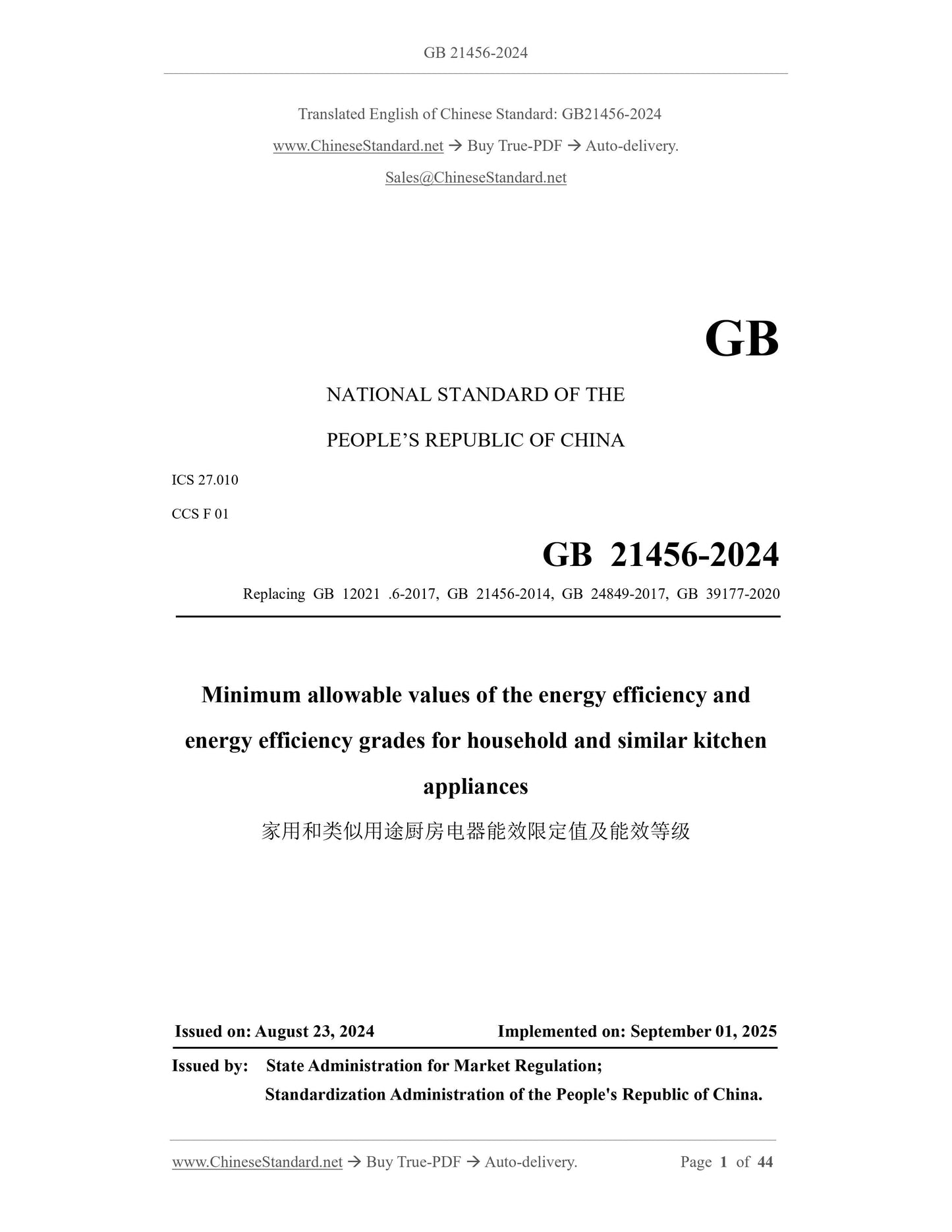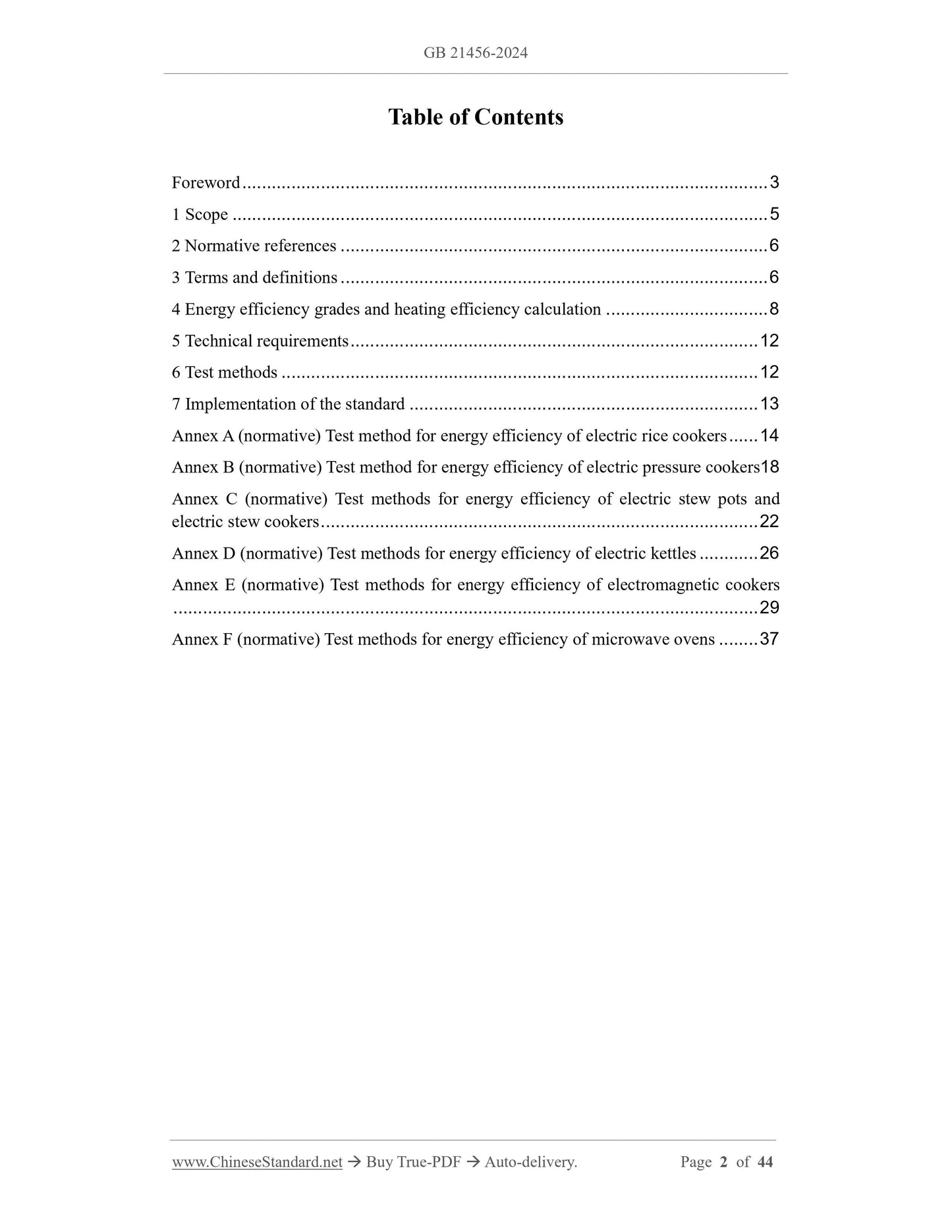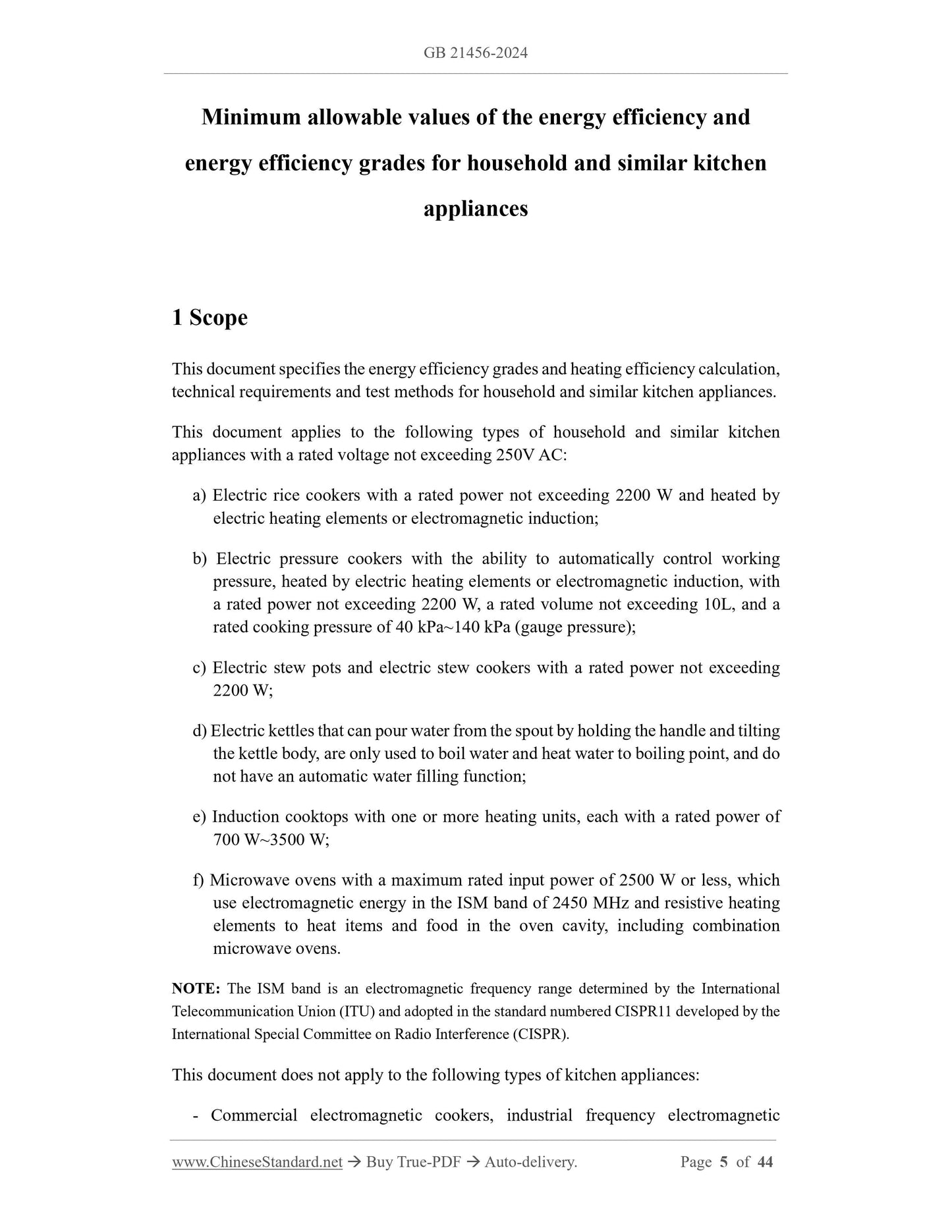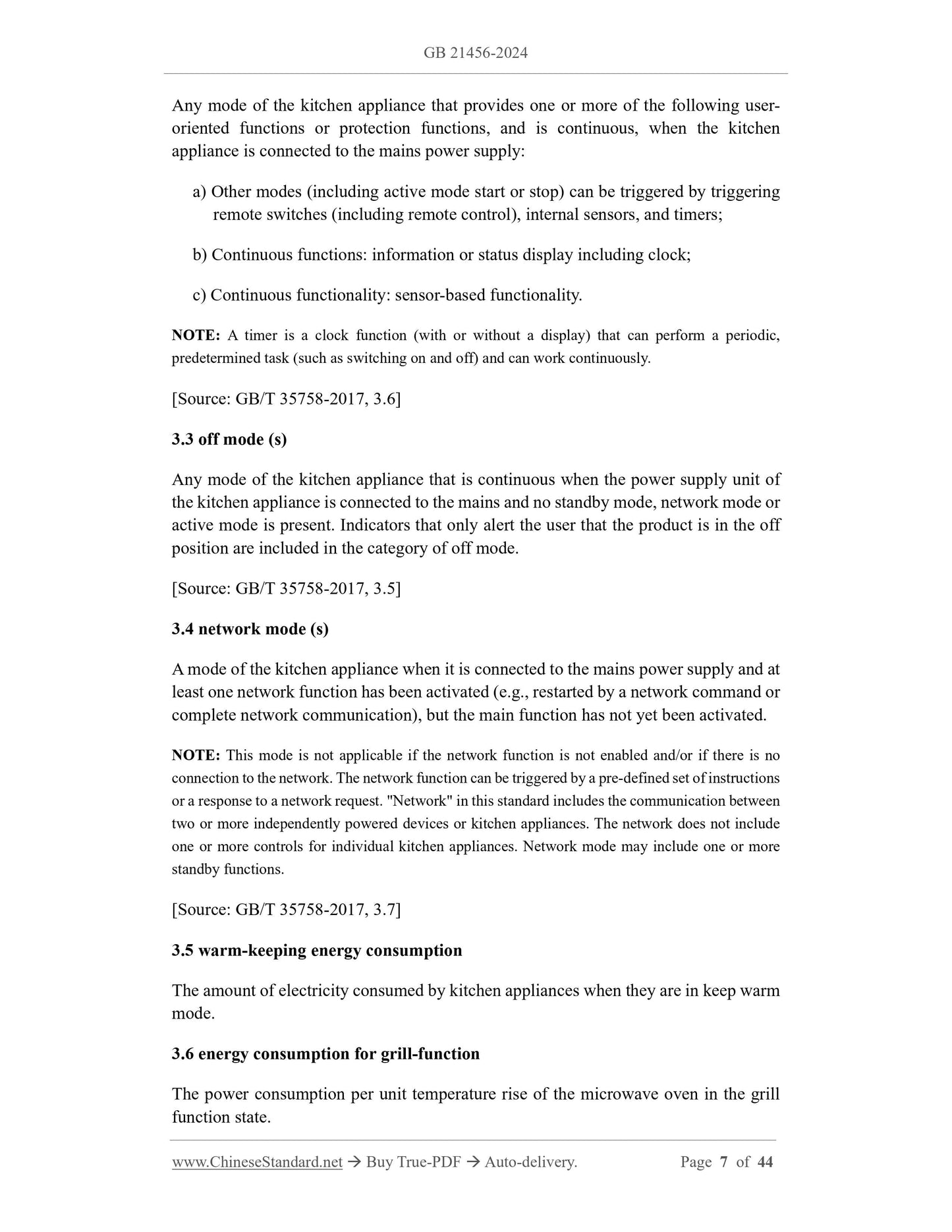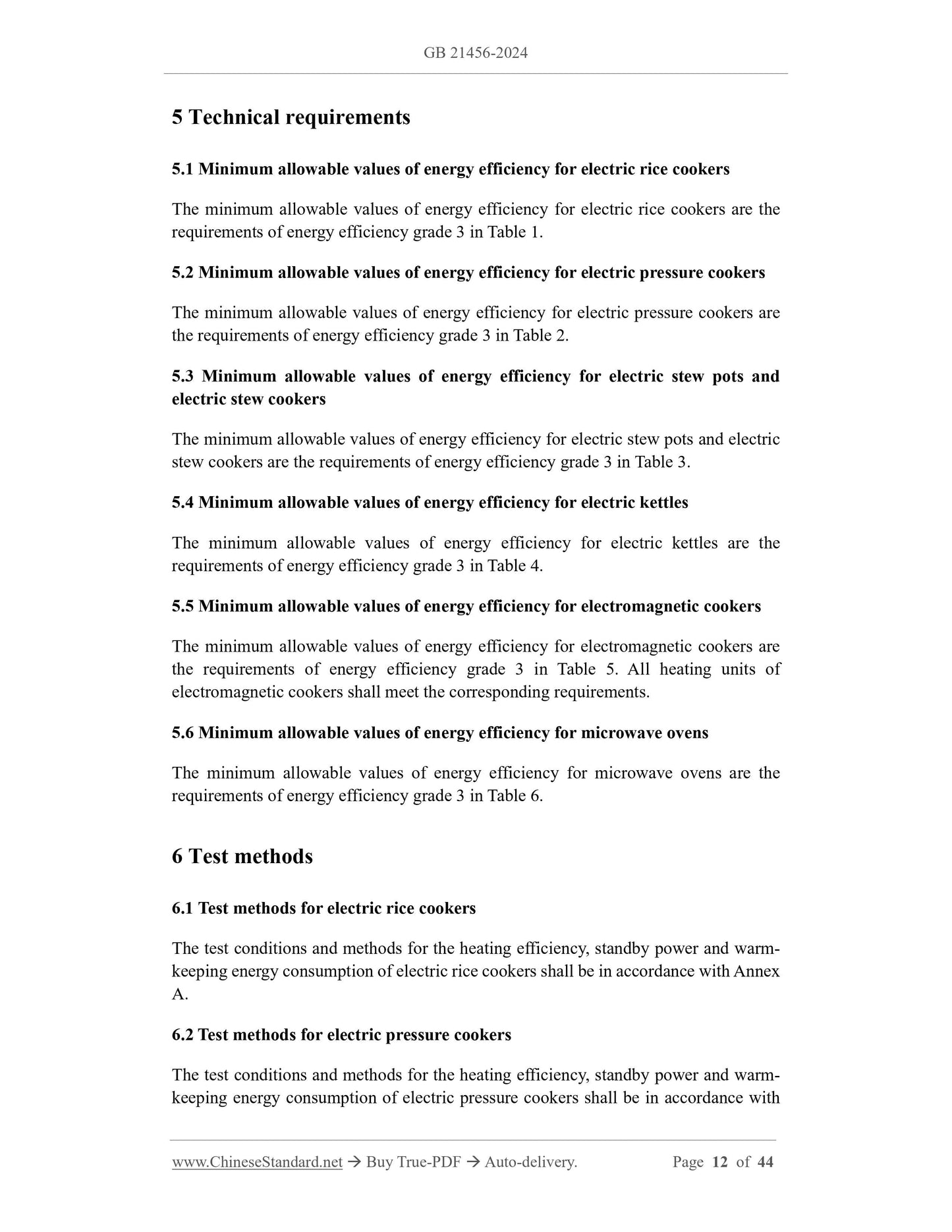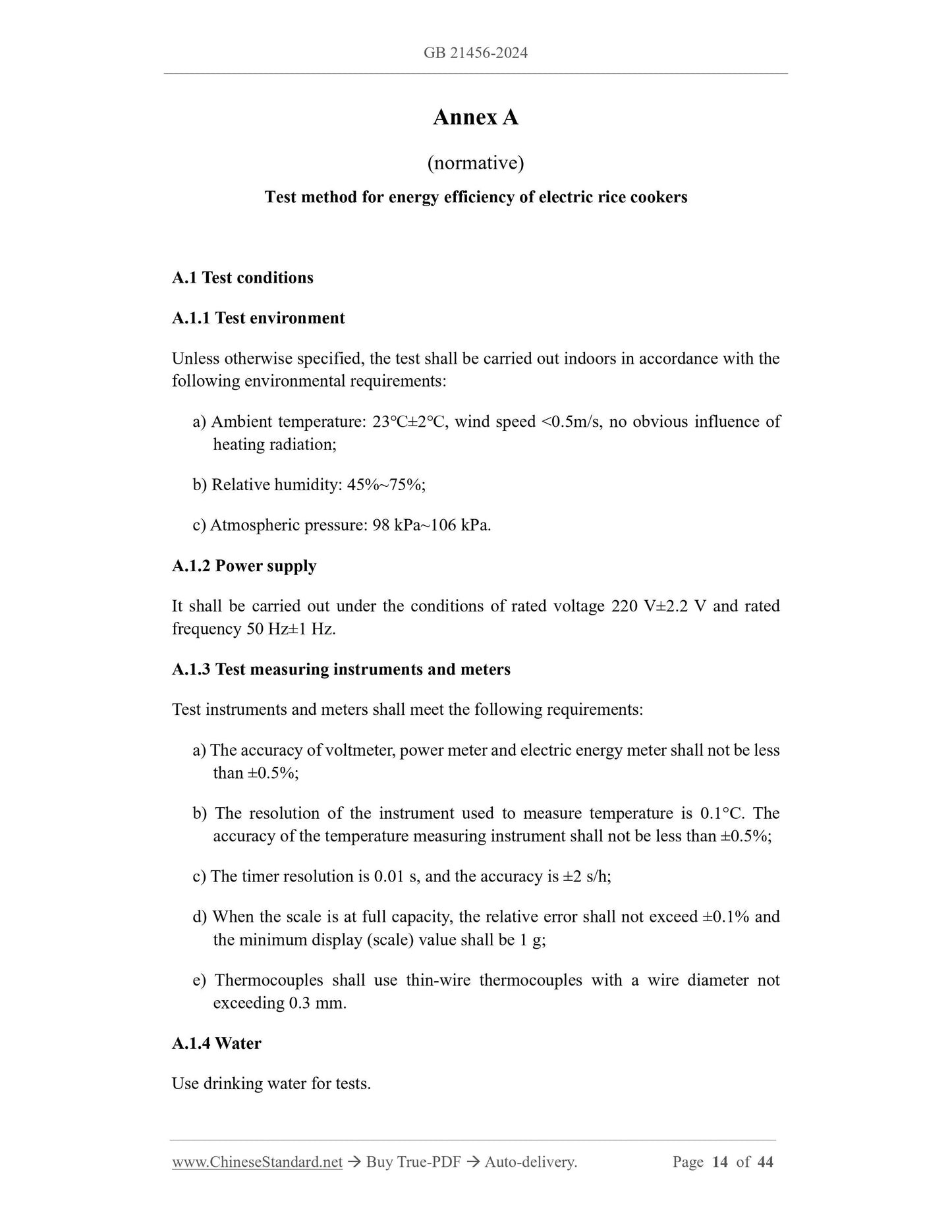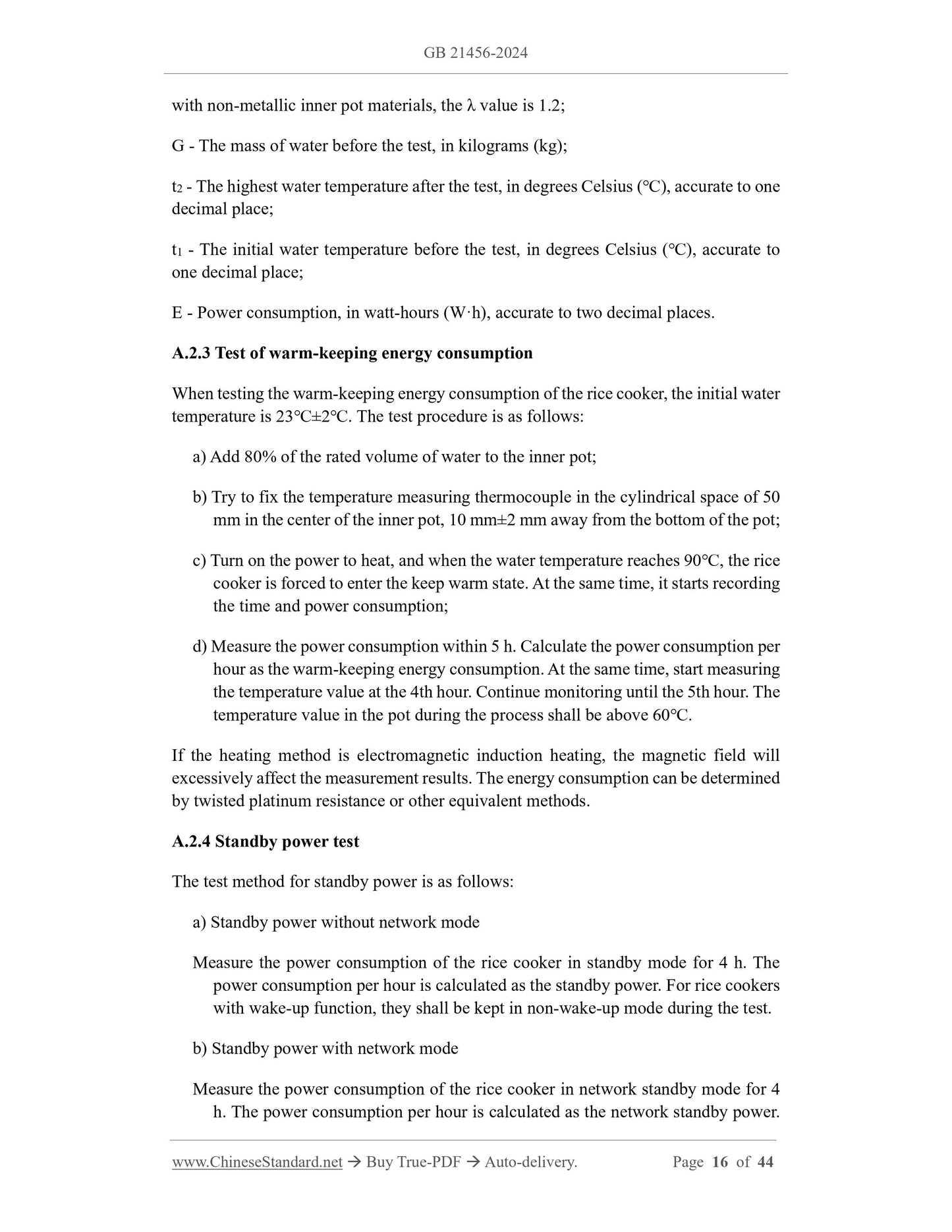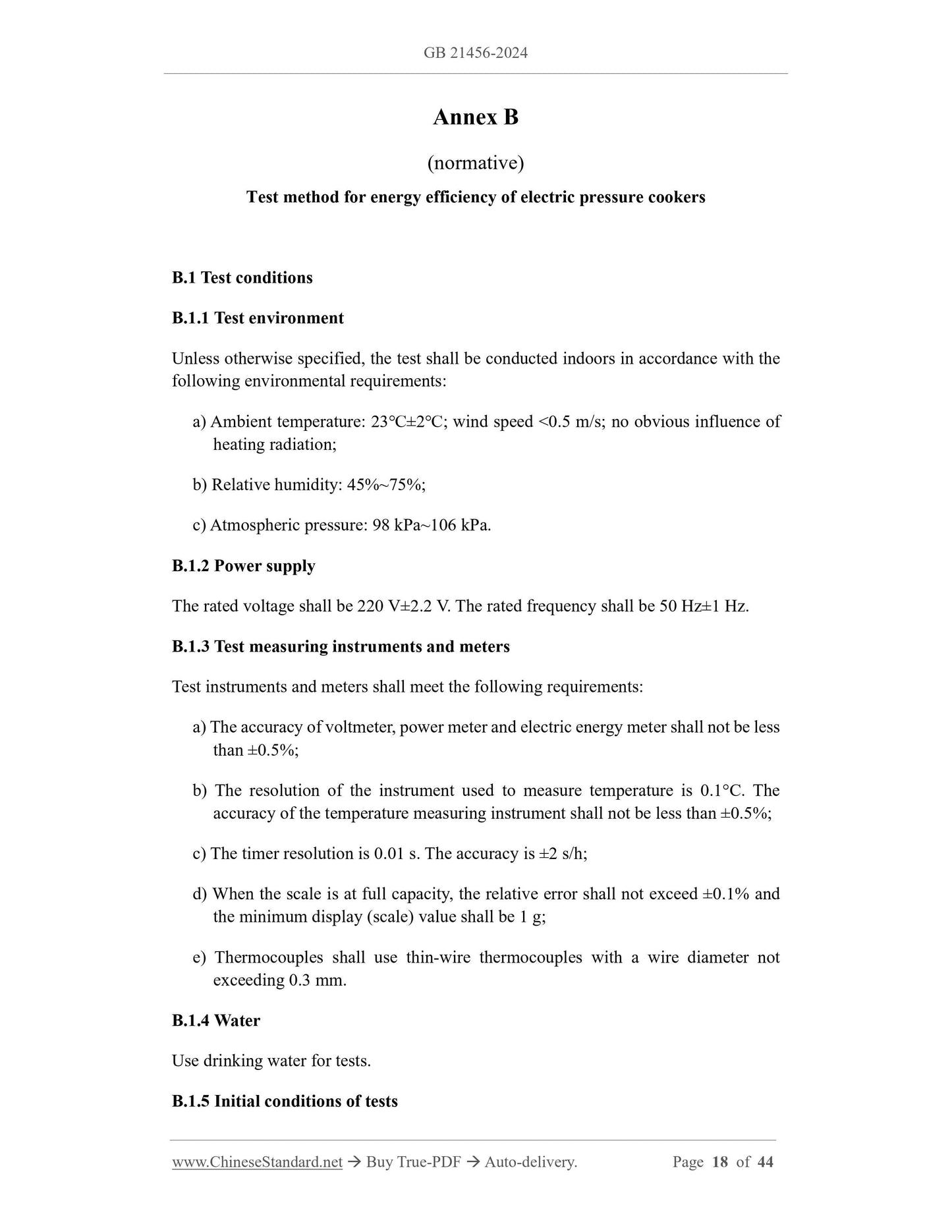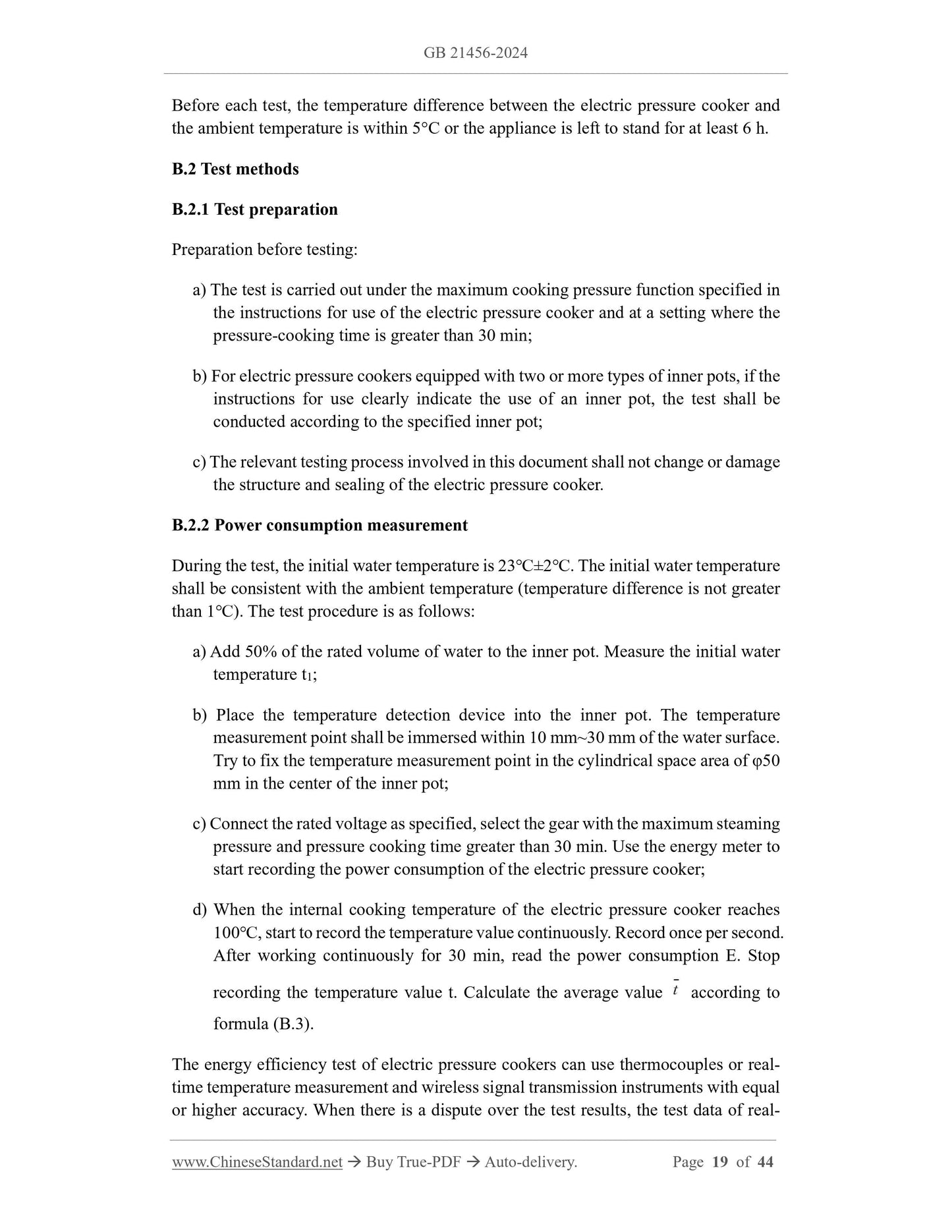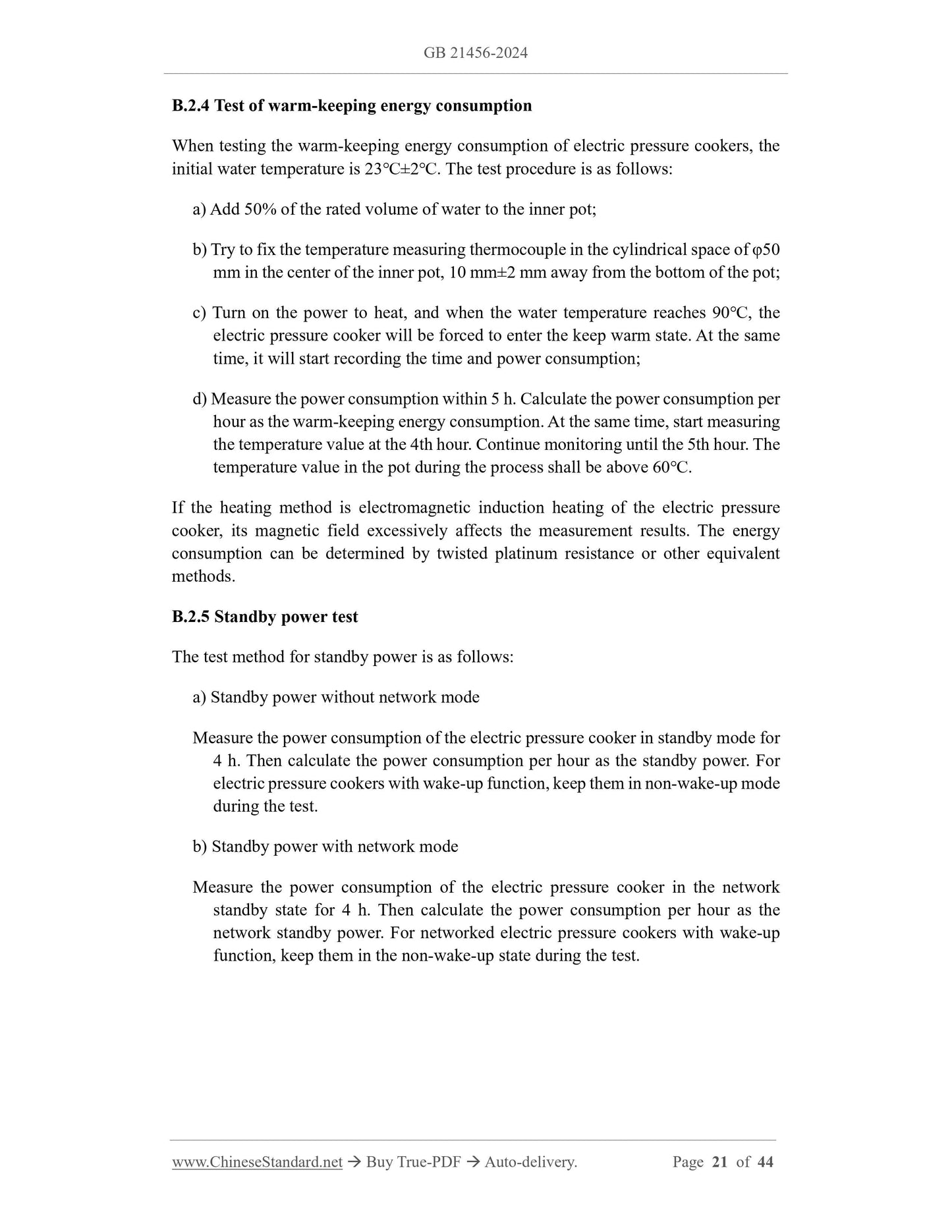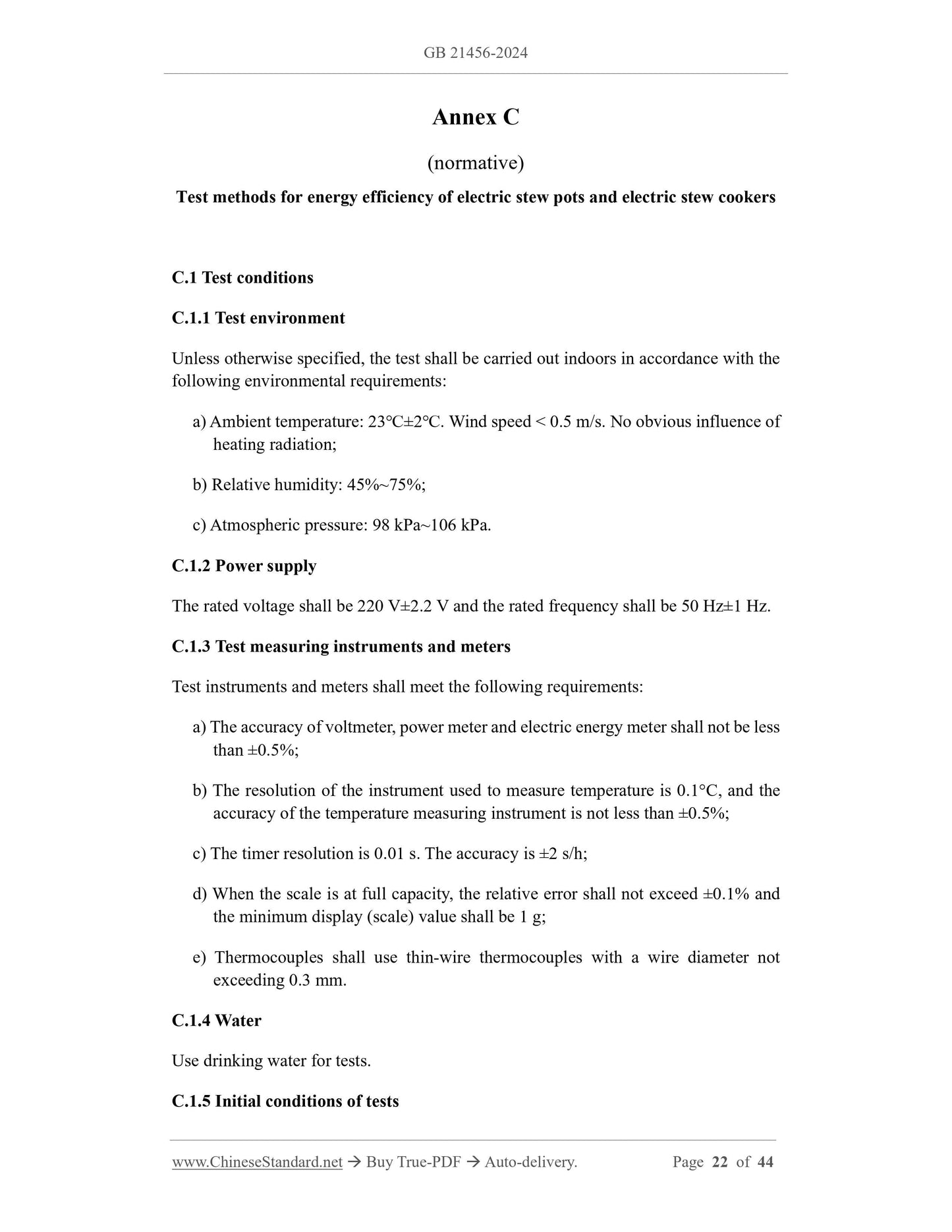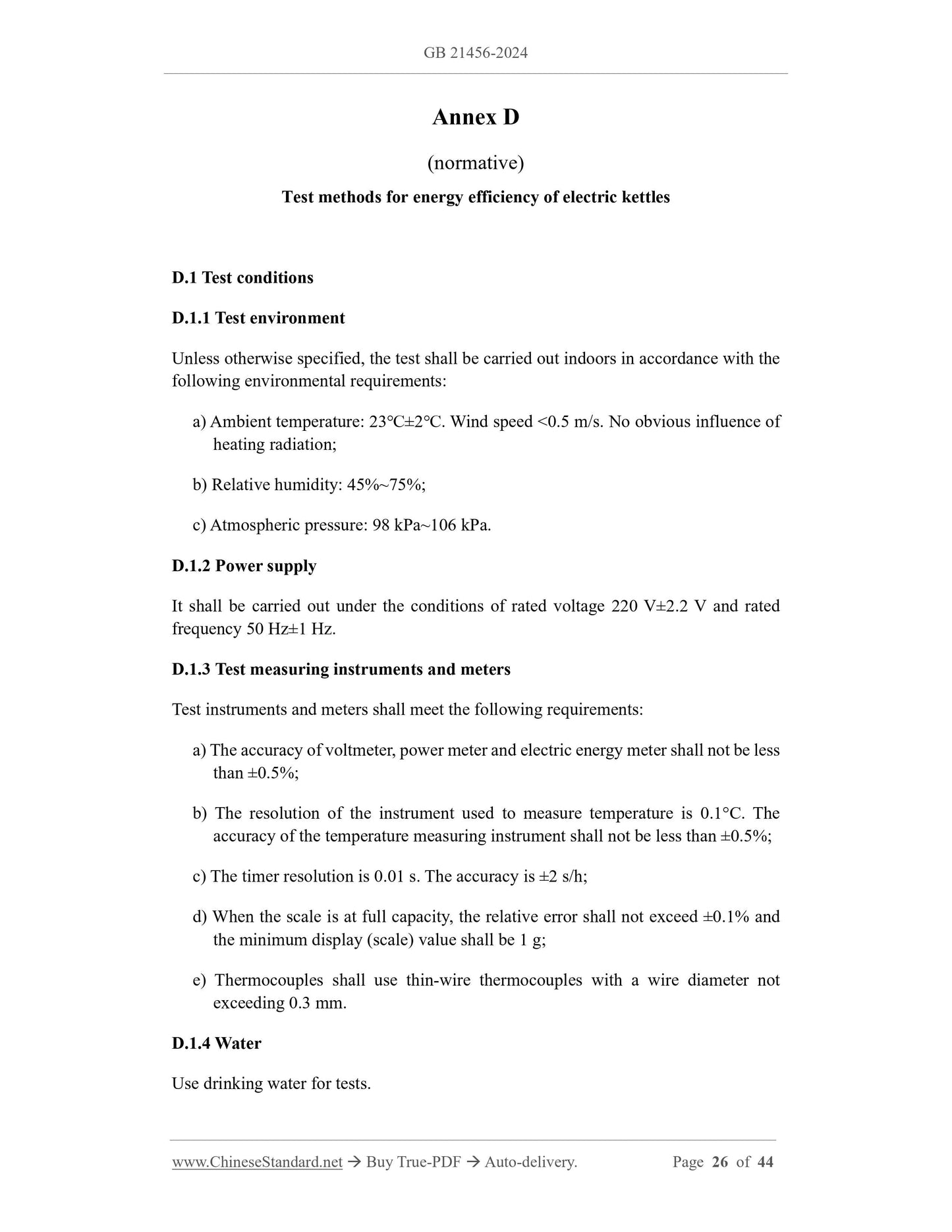1
/
of
12
PayPal, credit cards. Download editable-PDF and invoice in 1 second!
GB 21456-2024 English PDF (GB21456-2024)
GB 21456-2024 English PDF (GB21456-2024)
Regular price
$500.00 USD
Regular price
Sale price
$500.00 USD
Unit price
/
per
Shipping calculated at checkout.
Couldn't load pickup availability
Delivery: 3 seconds. Download true-PDF + Invoice.
Get QUOTATION in 1-minute: Click GB 21456-2024
Historical versions: GB 21456-2024
Preview True-PDF (Reload/Scroll if blank)
GB 21456-2024: Minimum allowable values of the energy efficiency and energy efficiency grades for household and similar kitchen appliances
GB 21456-2024
GB
NATIONAL STANDARD OF THE
PEOPLE’S REPUBLIC OF CHINA
ICS 27.010
CCS F 01
Replacing GB 12021.6-2017, GB 21456-2014, GB 24849-2017, GB 39177-2020
Minimum allowable values of the energy efficiency and
energy efficiency grades for household and similar kitchen
appliances
ISSUED ON. AUGUST 23, 2024
IMPLEMENTED ON. SEPTEMBER 01, 2025
Issued by. State Administration for Market Regulation;
Standardization Administration of the People's Republic of China.
Table of Contents
Foreword... 3
1 Scope... 5
2 Normative references... 6
3 Terms and definitions... 6
4 Energy efficiency grades and heating efficiency calculation... 8
5 Technical requirements... 12
6 Test methods... 12
7 Implementation of the standard... 13
Annex A (normative) Test method for energy efficiency of electric rice cookers... 14
Annex B (normative) Test method for energy efficiency of electric pressure cookers18
Annex C (normative) Test methods for energy efficiency of electric stew pots and
electric stew cookers... 22
Annex D (normative) Test methods for energy efficiency of electric kettles... 26
Annex E (normative) Test methods for energy efficiency of electromagnetic cookers
... 29
Annex F (normative) Test methods for energy efficiency of microwave ovens... 37
Minimum allowable values of the energy efficiency and
energy efficiency grades for household and similar kitchen
appliances
1 Scope
This document specifies the energy efficiency grades and heating efficiency calculation,
technical requirements and test methods for household and similar kitchen appliances.
This document applies to the following types of household and similar kitchen
appliances with a rated voltage not exceeding 250V AC.
a) Electric rice cookers with a rated power not exceeding 2200 W and heated by
electric heating elements or electromagnetic induction;
b) Electric pressure cookers with the ability to automatically control working
pressure, heated by electric heating elements or electromagnetic induction, with
a rated power not exceeding 2200 W, a rated volume not exceeding 10L, and a
rated cooking pressure of 40 kPa~140 kPa (gauge pressure);
c) Electric stew pots and electric stew cookers with a rated power not exceeding
2200 W;
d) Electric kettles that can pour water from the spout by holding the handle and tilting
the kettle body, are only used to boil water and heat water to boiling point, and do
not have an automatic water filling function;
e) Induction cooktops with one or more heating units, each with a rated power of
700 W~3500 W;
f) Microwave ovens with a maximum rated input power of 2500 W or less, which
use electromagnetic energy in the ISM band of 2450 MHz and resistive heating
elements to heat items and food in the oven cavity, including combination
microwave ovens.
NOTE. The ISM band is an electromagnetic frequency range determined by the International
Telecommunication Union (ITU) and adopted in the standard numbered CISPR11 developed by the
International Special Committee on Radio Interference (CISPR).
This document does not apply to the following types of kitchen appliances.
- Commercial electromagnetic cookers, industrial frequency electromagnetic
Any mode of the kitchen appliance that provides one or more of the following user-
oriented functions or protection functions, and is continuous, when the kitchen
appliance is connected to the mains power supply.
a) Other modes (including active mode start or stop) can be triggered by triggering
remote switches (including remote control), internal sensors, and timers;
b) Continuous functions. information or status display including clock;
c) Continuous functionality. sensor-based functionality.
NOTE. A timer is a clock function (with or without a display) that can perform a periodic,
predetermined task (such as switching on and off) and can work continuously.
[Source. GB/T 35758-2017, 3.6]
3.3 off mode (s)
Any mode of the kitchen appliance that is continuous when the power supply unit of
the kitchen appliance is connected to the mains and no standby mode, network mode or
active mode is present. Indicators that only alert the user that the product is in the off
position are included in the category of off mode.
[Source. GB/T 35758-2017, 3.5]
3.4 network mode (s)
A mode of the kitchen appliance when it is connected to the mains power supply and at
least one network function has been activated (e.g., restarted by a network command or
complete network communication), but the main function has not yet been activated.
NOTE. This mode is not applicable if the network function is not enabled and/or if there is no
connection to the network. The network function can be triggered by a pre-defined set of instructions
or a response to a network request. "Network" in this standard includes the communication between
two or more independently powered devices or kitchen appliances. The network does not include
one or more controls for individual kitchen appliances. Network mode may include one or more
standby functions.
[Source. GB/T 35758-2017, 3.7]
3.5 warm-keeping energy consumption
The amount of electricity consumed by kitchen appliances when they are in keep warm
mode.
3.6 energy consumption for grill-function
The power consumption per unit temperature rise of the microwave oven in the grill
function state.
5 Technical requirements
5.1 Minimum allowable values of energy efficiency for electric rice cookers
The minimum allowable values of energy efficiency for electric rice cookers are the
requirements of energy efficiency grade 3 in Table 1.
5.2 Minimum allowable values of energy efficiency for electric pressure cookers
The minimum allowable values of energy efficiency for electric pressure cookers are
the requirements of energy efficiency grade 3 in Table 2.
5.3 Minimum allowable values of energy efficiency for electric stew pots and
electric stew cookers
The minimum allowable values of energy efficiency for electric stew pots and electric
stew cookers are the requirements of energy efficiency grade 3 in Table 3.
5.4 Minimum allowable values of energy efficiency for electric kettles
The minimum allowable values of energy efficiency for electric kettles are the
requirements of energy efficiency grade 3 in Table 4.
5.5 Minimum allowable values of energy efficiency for electromagnetic cookers
The minimum allowable values of energy efficiency for electromagnetic cookers are
the requirements of energy efficiency grade 3 in Table 5.All heating units of
electromagnetic cookers shall meet the corresponding requirements.
5.6 Minimum allowable values of energy efficiency for microwave ovens
The minimum allowable values of energy efficiency for microwave ovens are the
requirements of energy efficiency grade 3 in Table 6.
6 Test methods
6.1 Test methods for electric rice cookers
The test conditions and methods for the heating efficiency, standby power and warm-
keeping energy consumption of electric rice cookers shall be in accordance with Annex
A.
6.2 Test methods for electric pressure cookers
The test conditions and methods for the heating efficiency, standby power and warm-
keeping energy consumption of electric pressure cookers shall be in accordance with
Annex A
(normative)
Test method for energy efficiency of electric rice cooke...
Get QUOTATION in 1-minute: Click GB 21456-2024
Historical versions: GB 21456-2024
Preview True-PDF (Reload/Scroll if blank)
GB 21456-2024: Minimum allowable values of the energy efficiency and energy efficiency grades for household and similar kitchen appliances
GB 21456-2024
GB
NATIONAL STANDARD OF THE
PEOPLE’S REPUBLIC OF CHINA
ICS 27.010
CCS F 01
Replacing GB 12021.6-2017, GB 21456-2014, GB 24849-2017, GB 39177-2020
Minimum allowable values of the energy efficiency and
energy efficiency grades for household and similar kitchen
appliances
ISSUED ON. AUGUST 23, 2024
IMPLEMENTED ON. SEPTEMBER 01, 2025
Issued by. State Administration for Market Regulation;
Standardization Administration of the People's Republic of China.
Table of Contents
Foreword... 3
1 Scope... 5
2 Normative references... 6
3 Terms and definitions... 6
4 Energy efficiency grades and heating efficiency calculation... 8
5 Technical requirements... 12
6 Test methods... 12
7 Implementation of the standard... 13
Annex A (normative) Test method for energy efficiency of electric rice cookers... 14
Annex B (normative) Test method for energy efficiency of electric pressure cookers18
Annex C (normative) Test methods for energy efficiency of electric stew pots and
electric stew cookers... 22
Annex D (normative) Test methods for energy efficiency of electric kettles... 26
Annex E (normative) Test methods for energy efficiency of electromagnetic cookers
... 29
Annex F (normative) Test methods for energy efficiency of microwave ovens... 37
Minimum allowable values of the energy efficiency and
energy efficiency grades for household and similar kitchen
appliances
1 Scope
This document specifies the energy efficiency grades and heating efficiency calculation,
technical requirements and test methods for household and similar kitchen appliances.
This document applies to the following types of household and similar kitchen
appliances with a rated voltage not exceeding 250V AC.
a) Electric rice cookers with a rated power not exceeding 2200 W and heated by
electric heating elements or electromagnetic induction;
b) Electric pressure cookers with the ability to automatically control working
pressure, heated by electric heating elements or electromagnetic induction, with
a rated power not exceeding 2200 W, a rated volume not exceeding 10L, and a
rated cooking pressure of 40 kPa~140 kPa (gauge pressure);
c) Electric stew pots and electric stew cookers with a rated power not exceeding
2200 W;
d) Electric kettles that can pour water from the spout by holding the handle and tilting
the kettle body, are only used to boil water and heat water to boiling point, and do
not have an automatic water filling function;
e) Induction cooktops with one or more heating units, each with a rated power of
700 W~3500 W;
f) Microwave ovens with a maximum rated input power of 2500 W or less, which
use electromagnetic energy in the ISM band of 2450 MHz and resistive heating
elements to heat items and food in the oven cavity, including combination
microwave ovens.
NOTE. The ISM band is an electromagnetic frequency range determined by the International
Telecommunication Union (ITU) and adopted in the standard numbered CISPR11 developed by the
International Special Committee on Radio Interference (CISPR).
This document does not apply to the following types of kitchen appliances.
- Commercial electromagnetic cookers, industrial frequency electromagnetic
Any mode of the kitchen appliance that provides one or more of the following user-
oriented functions or protection functions, and is continuous, when the kitchen
appliance is connected to the mains power supply.
a) Other modes (including active mode start or stop) can be triggered by triggering
remote switches (including remote control), internal sensors, and timers;
b) Continuous functions. information or status display including clock;
c) Continuous functionality. sensor-based functionality.
NOTE. A timer is a clock function (with or without a display) that can perform a periodic,
predetermined task (such as switching on and off) and can work continuously.
[Source. GB/T 35758-2017, 3.6]
3.3 off mode (s)
Any mode of the kitchen appliance that is continuous when the power supply unit of
the kitchen appliance is connected to the mains and no standby mode, network mode or
active mode is present. Indicators that only alert the user that the product is in the off
position are included in the category of off mode.
[Source. GB/T 35758-2017, 3.5]
3.4 network mode (s)
A mode of the kitchen appliance when it is connected to the mains power supply and at
least one network function has been activated (e.g., restarted by a network command or
complete network communication), but the main function has not yet been activated.
NOTE. This mode is not applicable if the network function is not enabled and/or if there is no
connection to the network. The network function can be triggered by a pre-defined set of instructions
or a response to a network request. "Network" in this standard includes the communication between
two or more independently powered devices or kitchen appliances. The network does not include
one or more controls for individual kitchen appliances. Network mode may include one or more
standby functions.
[Source. GB/T 35758-2017, 3.7]
3.5 warm-keeping energy consumption
The amount of electricity consumed by kitchen appliances when they are in keep warm
mode.
3.6 energy consumption for grill-function
The power consumption per unit temperature rise of the microwave oven in the grill
function state.
5 Technical requirements
5.1 Minimum allowable values of energy efficiency for electric rice cookers
The minimum allowable values of energy efficiency for electric rice cookers are the
requirements of energy efficiency grade 3 in Table 1.
5.2 Minimum allowable values of energy efficiency for electric pressure cookers
The minimum allowable values of energy efficiency for electric pressure cookers are
the requirements of energy efficiency grade 3 in Table 2.
5.3 Minimum allowable values of energy efficiency for electric stew pots and
electric stew cookers
The minimum allowable values of energy efficiency for electric stew pots and electric
stew cookers are the requirements of energy efficiency grade 3 in Table 3.
5.4 Minimum allowable values of energy efficiency for electric kettles
The minimum allowable values of energy efficiency for electric kettles are the
requirements of energy efficiency grade 3 in Table 4.
5.5 Minimum allowable values of energy efficiency for electromagnetic cookers
The minimum allowable values of energy efficiency for electromagnetic cookers are
the requirements of energy efficiency grade 3 in Table 5.All heating units of
electromagnetic cookers shall meet the corresponding requirements.
5.6 Minimum allowable values of energy efficiency for microwave ovens
The minimum allowable values of energy efficiency for microwave ovens are the
requirements of energy efficiency grade 3 in Table 6.
6 Test methods
6.1 Test methods for electric rice cookers
The test conditions and methods for the heating efficiency, standby power and warm-
keeping energy consumption of electric rice cookers shall be in accordance with Annex
A.
6.2 Test methods for electric pressure cookers
The test conditions and methods for the heating efficiency, standby power and warm-
keeping energy consumption of electric pressure cookers shall be in accordance with
Annex A
(normative)
Test method for energy efficiency of electric rice cooke...
Share
